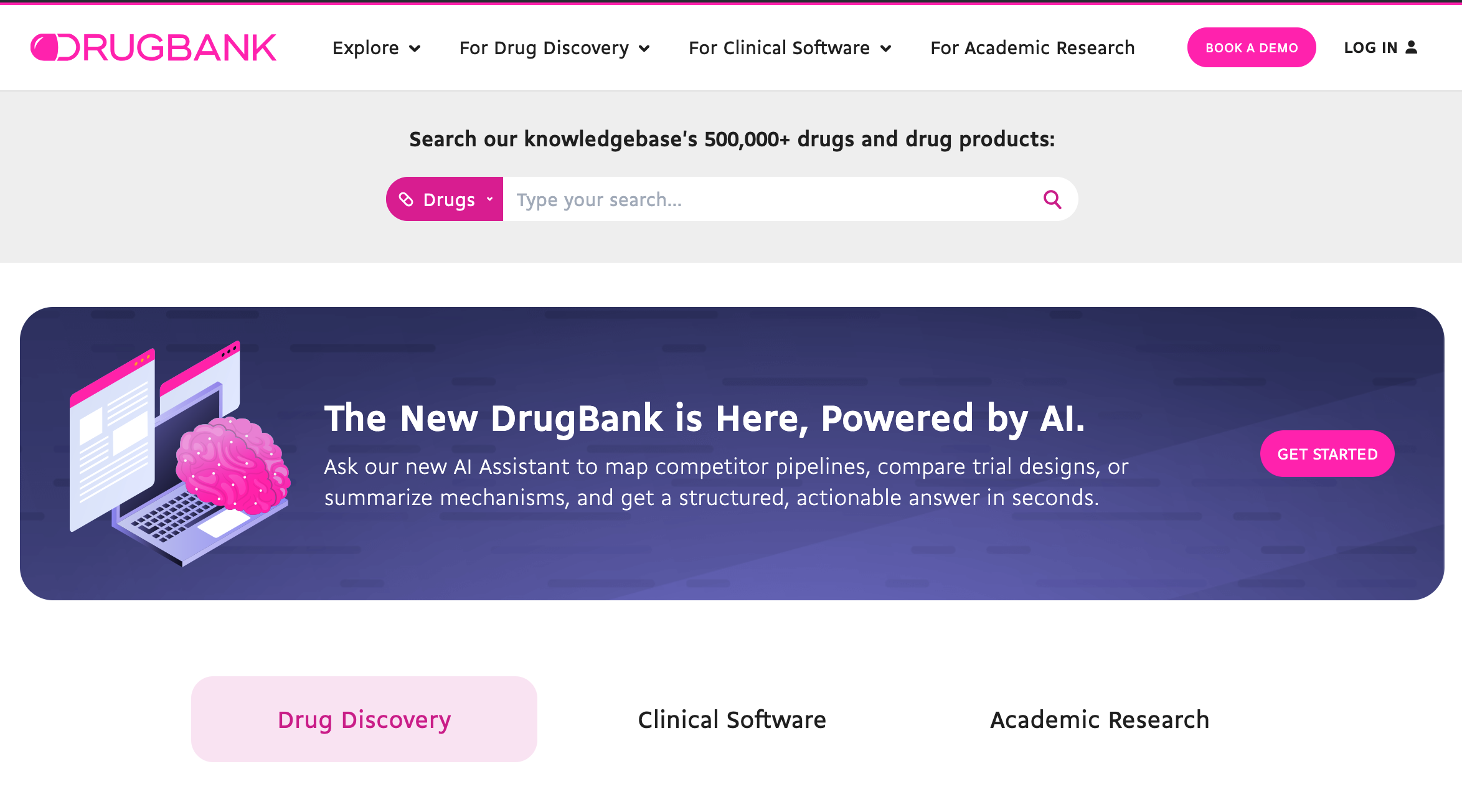Topic 2 | Drugs and Molecular Information
📅 Date: 22/23 September 2025
📖 Synopsis: Exploring databases: DrugBank, NCBI
Lecture topics
- Retrieving drug and compound information - DrugBank
- Accessing reference sequences and molecular records - NCBI
- Linking chemical and molecular data - DrugBank / NCBI
Learning goals
- Learn how to retrieve drug and target information from online resources.
- Explore NCBI as a central entry point for biological data.
- Connect pharmacological and molecular data sources.
Introduction
This class explores two important yet very different databases: DrugBank and NCBI.
DrugBank focuses on drugs, their molecular targets, and clinical information, while NCBI is a broad platform that integrates many types of biological data, from genes and proteins to literature and clinical variants.
Together, they show how specialised and general-purpose resources can complement each other, and why learning to navigate both is essential for connecting drug information with the underlying biology.
Challenges
Using these large online resources for the first time presents some challenges and common difficulties:
Information overload: both DrugBank and NCBI contain a lot of data and links; you may feel lost in deciding what is essential versus background.
Navigation structure: NCBI in particular is a collection of many sub-databases (Gene, PubMed, ClinVar, GEO, etc.), and you may not immediately know which one to enter or how to move between them.
Technical terminology: drug mechanisms, gene names, and clinical annotations use specialised vocabulary that may not yet be familiar to you.
Cross-referencing: following links across databases (e.g., from DrugBank to UniProt, or from NCBI Gene to PubMed articles) can feel like “falling down a rabbit hole” without a clear strategy.
Search skills: knowing what search terms to use (drug name, gene symbol, disease, accession number) and how to refine results can be challenging at the start.
It’s normal to feel a bit overwhelmed when using any online Bioinformatics resource for the first time. These databases are large and detailed, and nobody masters them right away. With practice, the structure becomes more familiar, and you will quickly learn how to find the information you need. Don’t worry if it feels slow at the beginning - every search builds your confidence, and over time the process becomes natural. By the end of these classes you will feel confident finding your way around key bioinformatics databases.
Databases overview
DrugBank

1. Purpose | A resource that combines detailed information on drugs with their molecular targets and mechanisms of action.
2. Content | Includes approved and experimental drugs, chemical structures, pharmacological data, molecular targets (genes/proteins), pathways, interactions, and related clinical information.
3. Typical Use Cases
- Identify the molecular target of a drug (e.g., which enzyme or receptor it binds).
- Explore known drug–drug interactions.
- Check clinical indications and side effects.
- Find links between drugs and genetic information.
4. External Connections | Cross-linked with many complementary resources such as UniProt (proteins), KEGG (pathways), PubChem/ChEMBL (chemical compounds), and NCBI (gene information), SMPDB (small molecule pathways), among others.
NCBI - National Center for Biotechnology Information
 URL: https://www.ncbi.nlm.nih.gov
URL: https://www.ncbi.nlm.nih.gov
1. Purpose | A central hub providing access to a wide range of biological and biomedical databases and tools, covering genes, genomes, proteins, literature, and clinical information.
2. Content | Includes PubMed (scientific literature), Gene (gene information), Nucleotide and Protein sequence databases, ClinVar (clinical variants), dbSNP (genetic variation), GEO (expression data), and many others.
3. Typical Use Cases
- Search for scientific articles on a drug, gene, or disease.
- Look up detailed information about a specific gene or protein.
- Explore genetic variants and their clinical significance.
- Access genomic and transcriptomic datasets for analysis.
4. External Connections | Cross-linked with numerous resources such as UniProt (proteins), OMIM (diseases), KEGG/Reactome (pathways), RCSB PDB (structures), and DrugBank (drugs and targets), among many others.
Class Live Demonstration
In this session, we will begin with a live demonstration of one drug entry: either suggested by the class or chosen by the instructor (for example, metformin), to show the main features and how to navigate these two databases.
TP Activity 2
Ibuprofen & Prostaglandin Pathways
Goal:
- Learn how to explore and critically interpret bioinformatics resources by connecting Ibuprofen with its molecular targets.
- Understand its pharmacological action, mechanism of action, and clinical relevance.
- Use the following databases: DrugBank, NCBI.
How to work:
Search for Ibuprofen in DrugBank.
Review the DrugBank entry and use it to answer the worksheet questions.
- Support each answer with a reference (link, screenshot, or citation) so it can be verified.
Tip: DrugBank links to many other databases with complementary information about targets, diseases, pathways, and genetic details. Be pragmatic: choose the linked resources most useful for answering the worksheet.
Below you can view the worksheet. To complete it, please use the template file provided in the class’s Tutoria eletrónica.
Woksheet | Ibuprofen & Prostaglandin Pathways
Student and Activity Identification
Activity number: ____________________________
Date & TP group: ____________________________
Student(s) name(s): ___________________________
Drug-Molecular Target report
Drug name: ____________________________
Molecular target (gene/protein): ____________________________
1. Drug Basics
- Therapeutic category: _____________________________________
- Therapeutic use(s): ______________________________
- Mechanism of action (summary): ___________________
- Common adverse effects (linked to mechanism): ____
2. Target Identity
- Official gene name + synonyms: ___________________
- Protein function (normal physiology): ______________
- Tissue expression (where is it active?): ____________
- Pathophysiological relevance (diseases associated with target) ____________________________
3. Molecular Mechanism (extra credit)
- Where does the drug bind? ________________________
- Is there a known 3D structure with drug bound? (yes/no; PDB ID if found)
- Variants or mutations affecting drug response: ______
- Pathways involved (KEGG/Reactome): ______________
4. Clinical and Translational Relevance (extra credit)
- Known resistance mechanisms: ____________________
- Drug–drug interactions (key enzymes, e.g. CYPs): ____
- Biomarkers of response (if any): ___________________
- Approved vs experimental/repurposed uses: _________
5. Integrated Reflection
Why is this drug–target pair important in pharmacology?
One new/surprising fact I found for this drug-target pair: